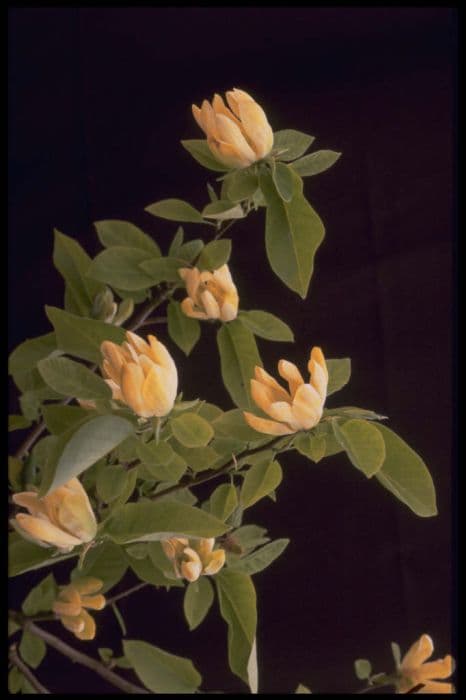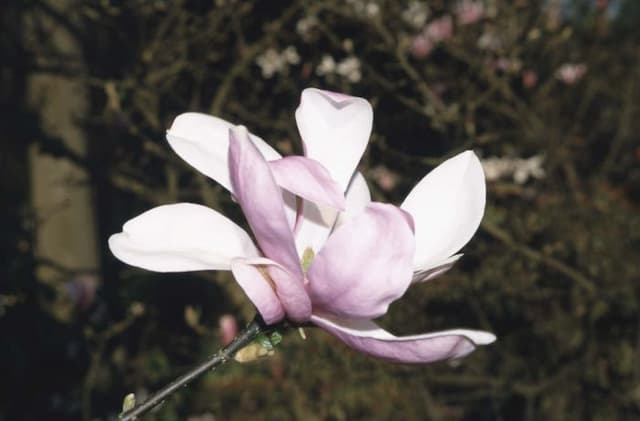Magnolia Magnolia 'Ian's Red'

ABOUT
Magnolia 'Ian's Red' is a striking ornamental plant known for its vibrant and large flowers. The blooms are a deep, rich red or ruby color with a waxy appearance, drawing the eye with their bold hue. The petals of the flowers are thick and broad, often appearing cup-shaped when fully open. These blossoms exude a heady, sweet fragrance that can be detected from a distance, creating an aromatic presence in the garden. The leaves of Magnolia 'Ian's Red' are glossy and leathery, offering a verdant backdrop to the spectacular flowers. They are typically dark green and may have a slightly paler underside, which contrasts beautifully with the red flowers. Underneath the foliage, the bark of the Magnolia 'Ian's Red' is smooth, providing an understated yet elegant textural component to the plant. Overall, the appearance of Magnolia 'Ian's Red' is characterized by its lush foliage and particularly by its show-stopping red flowers, which make it a focal point of any garden setting during its blooming season.
About this plant
 Names
NamesFamily
Magnoliaceae
Synonyms
Ian's Red Magnolia
Common names
Magnolia 'Ian's Red'.
 Toxicity
ToxicityTo humans
Magnolia, including the 'Ian's Red' variety, is not known to be toxic to humans. Generally, magnolias are considered non-toxic, and there are no common reports of poisoning or adverse symptoms from ingesting parts of magnolia plants. However, it is always advisable to avoid eating any plant material unless you are certain it is safe to consume.
To pets
Magnolia, including the 'Ian's Red' variety, is not typically toxic to pets such as cats and dogs. Magnolia plants are considered to be quite safe for pets, and there is no well-documented evidence of toxicity. However, it's always best practice to prevent pets from eating ornamental plants as a precautionary measure.
 Characteristics
CharacteristicsLife cycle
Perennials
Foliage type
Deciduous
Color of leaves
Green
Flower color
Red
Height
10-20 feet (3-6 meters)
Spread
6-12 feet (2-4 meters)
Plant type
Tree
Hardiness zones
7
Native area
North America
Benefits
 General Benefits
General Benefits- Aesthetic Appeal: Magnolia 'Ian's Red' has large, showy red flowers that can add dramatic visual interest to any landscape.
- Year-Round Interest: With its broad, glossy leaves and attractive form, this magnolia provides beauty throughout all seasons.
- Shade Providing: The thick foliage creates a cooling shade, making it a suitable option for sunny spots and seating areas.
- Habitat Support: Provides food and shelter for a variety of wildlife, including birds and beneficial insects.
- Low Maintenance: Once established, Magnolia 'Ian's Red' requires minimal care, making it a good choice for gardeners of all levels.
- Privacy Screen: When planted in a row or group, it can create a natural privacy screen for your property.
- Longevity: Magnolias are known for their long life-span, giving long-term enjoyment where they are planted.
- Versatility: Can be used in different garden styles, including formal, cottage, and woodland gardens.
- Resilience: Magnolia 'Ian's Red' can tolerate a range of soil types and is relatively resistant to pests and diseases.
- Heritage Value: Magnolias are considered 'living fossils', as they are one of the oldest flowering plants, offering historical significance to a garden.
 Medical Properties
Medical PropertiesThis plant is not used for medical purposes.
 Air-purifying Qualities
Air-purifying QualitiesThis plant is not specifically known for air purifying qualities.
 Other Uses
Other Uses- Magnolia leaf infusion can be used as a gentle cleanser for delicate fabrics that cannot withstand harsh chemicals.
- The bark of the magnolia tree, when processed, can serve as a natural dye for textiles, providing a range of warm brown tones.
- Wood from magnolia trees can be used in fine woodworking, such as for crafting small boxes or inlays.
- Dried magnolia leaves make excellent additions to potpourri mixes, offering a subtle, woody fragrance.
- Magnolia blossoms can be candied and used as decorative, edible additions to desserts or as a sweet treat.
- The strong, flexible wood of magnolia trees is suitable for making garden furniture that can weather outdoor conditions.
- Leaves of the magnolia can be used to create unique nature-inspired art prints or as a stencil in crafting.
- The seeds of magnolia can be pressed to extract an oil that is used as a base for various artisanal perfumes.
- Magnolia flowers can be used as a natural source of pigment in botanical watercolor painting.
- The fibrous bark of magnolia trees can be processed into a sustainable, biodegradable material for crafting handmade paper.
Interesting Facts
 Feng Shui
Feng ShuiThe Magnolia is not used in Feng Shui practice.
 Zodiac Sign Compitability
Zodiac Sign CompitabilityThe Magnolia is not used in astrology practice.
 Plant Symbolism
Plant Symbolism- Nobility: Magnolias are often associated with nobility and dignity due to their impressive appearance and longstanding presence in gardens.
- Purity: The magnolia's white flowers symbolize purity and cleanliness, making it a popular plant in bridal bouquets and decorations.
- Perseverance: Able to grow in difficult conditions and survive harsh climates, the magnolia represents perseverance and endurance.
- Femininity: The delicate and graceful aspects of the magnolia are often linked to qualities of femininity and softness.
- Hospitality: In the American South, the magnolia tree represents a warm and welcoming environment, often planted near homes to signal hospitality.
 Water
WaterFor a Magnolia 'Ian's Red', also known as Red Magnolia, the watering should be done deeply and slowly to ensure that the water reaches the roots. In the growing season, it often requires watering once a week, but this can vary based on your climate and weather conditions. Typically, aim for about 1.5 gallons per week for smaller trees, and increase to 2-3 gallons for larger, established trees. During hot spells or drought, watering frequency may need to increase. During winter, water only as needed to prevent the soil from completely drying out.
 Light
LightRed Magnolia thrives best in full sun to partial shade. The ideal spot would allow it to receive at least 4-6 hours of direct sunlight daily, ensuring bright conditions without prolonged exposure to scorching midday sun which can be harmful. Young trees benefit from some protection from excessively harsh rays.
 Temperature
TemperatureRed Magnolia prefers temperate conditions and can generally tolerate temperatures as low as 0°F and as high as 100°F. However, the ideal temperature for this Magnolia ranges from 70°F to 85°F. They can suffer damage from late spring frosts, so while they can endure cold winters, it's best to plant them in a location that minimizes frost risk.
 Pruning
PruningRed Magnolia benefits from pruning to maintain its shape and remove any dead or crossed branches. The best time to prune is in late winter or early spring before new growth starts. Prune sparingly, focusing solely on maintaining the natural shape of the tree and removing damaged branches to promote healthy growth. Pruning can be done annually or as needed to remove dead wood.
 Cleaning
CleaningAs needed
 Soil
SoilThe Magnolia 'Ian's Red', commonly known as magnolia, thrives best in a soil mix that is rich, well-drained, and acidic with a pH of 5.0 to 6.5. An ideal soil mixture would consist of one part compost, one part pine bark, and one part coarse sand to ensure proper drainage and nutrient retention.
 Repotting
RepottingMagnolias, including the 'Ian's Red', do not need frequent repotting and can often thrive in the same pot for several years. Generally, repotting every 3-5 years is adequate, allowing the plant to establish and not disrupt its growth cycle.
 Humidity & Misting
Humidity & MistingMagnolia 'Ian's Red' prefers moderate to high humidity levels. Maintaining around 50-60% humidity is ideal for this type of magnolia to flourish, replicating its natural humid habitat.
 Suitable locations
Suitable locationsIndoor
Ensure bright light, proper pruning, and acid soil for indoor magnolias.
Outdoor
Plant in acidic soil, partial shade, and shelter from strong wind.
Hardiness zone
5-9 USDA
 Life cycle
Life cycleMagnolia 'Ian's Red' begins its life cycle as a seed, which, once germinated, develops into a seedling with its initial set of true leaves. As the sapling grows, it forms a woody stem and a root system that allows it to establish and gather nutrients and water. During its juvenile phase, the plant develops its characteristic foliage and structure, but does not yet flower. Upon reaching maturity, which can take several years, it produces the striking red to deep pink blooms that make it popular, usually in early spring. After pollination, typically by beetles adapted to magnolias, the tree sets seed in cone-like fruit that, when ripe, releases seeds to propagate the next generation. Over time, the mature Magnolia 'Ian's Red' may experience cycles of growth and dormancy annually, with flowering and seed production being recurrent events in its life until it reaches senescence and eventually dies.
 Propogation
PropogationPropogation time
Spring-Early Summer
The best time to propagate the Magnolia 'Ian's Red', typically a hybrid magnolia, is in the spring or early summer when the plant is actively growing. The most popular method of propagation for this plant is through semi-hardwood cuttings. This entails taking a cutting of about 4 to 6 inches (10 to 15 centimeters) long from a healthy branch, ensuring there are at least two to three sets of leaves. The bottom leaves are removed, and the cut end is often treated with a rooting hormone to enhance the chances of successful rooting. The cutting is then placed into a well-draining potting mix, ensuring the remaining leaves are above the soil surface. The pot is kept in a warm location with indirect sunlight, and the soil is maintained moist but not waterlogged. Roots typically develop within a few weeks, after which the new magnolia plant can eventually be transplanted outdoors.



![Magnolia [Black Tulip]](/_next/image?url=https%3A%2F%2Fplants-admin.emdemapps.com%2Fimages%2Fplants%2F%2Fimages%2F604b590290fc7.png&w=640&q=75)


![Magnolia [Fairy Blush]](/_next/image?url=https%3A%2F%2Fplants-admin.emdemapps.com%2Fimages%2Fplants%2F%2Fimages%2F604b5a108e959.png&w=640&q=75)


